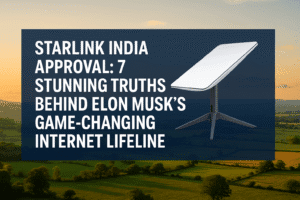Starlink India Approval: 7 Stunning Truths Behind Elon Musk’s Game-Changing Internet Lifeline
Starlink secures Indian approval but faces hurdles before launch (late 2025/2026), joining OneWeb and Jio in the satellite internet race. Its true value shines in remote areas lacking terrestrial options, acting as a lifeline for farmers, villages, and mobile professionals despite high costs: expect ~₹30,000 hardware and ~₹3,000 monthly unlimited plans. Urban users face impractical pricing, especially with a potential ₹500 surcharge, making fiber/5G far more economical. Performance varies (20-264 Mbps), lags behind fiber latency, and requires clear sky views.
Partnerships with Jio/Airtel aim to boost accessibility, while BSNL explores hybrid alternatives. Ultimately, Starlink expands India’s connectivity frontier but remains a niche, premium solution focused on bridging the digital divide where traditional networks fail.

Starlink India Approval: 7 Stunning Truths Behind Elon Musk’s Game-Changing Internet Lifeline
Elon Musk’s Starlink has finally cleared the last regulatory hurdle, securing IN-SPACe approval to operate its satellite internet service in India for the next five years. While headlines announce the arrival, the real story lies in understanding what this means for different Indians – beyond the corporate press releases and price speculation.
Here’s a grounded look at the implications, challenges, and genuine opportunities:
The Approval: More Than Just a Green Light
- Not an Instant Launch: Approval doesn’t mean service starts tomorrow. Starlink must still build ground infrastructure, secure spectrum allocation, and pass rigorous security and performance tests mandated by IN-SPACe. Expect a phased rollout, likely late 2025 or early 2026.
- Playing Catch-Up: Starlink enters as the third approved player, following OneWeb (Eutelsat) and Reliance Jio’s satellite venture. The race to connect India’s unconnected has officially intensified.
- Tech Specs: Starlink will initially use its existing “Gen1” satellite constellation, known for lower latency than traditional geostationary satellites but potentially facing capacity challenges in dense urban areas.
The Promise: Who Stands to Benefit Most?
- Rural & Remote Realities: This is Starlink’s core strength. Forget laying fibre through mountains or jungles. If you have a clear view of the sky, Starlink can work. Farmers, remote villages, researchers in isolated areas, and critical infrastructure sites (like weather stations) gain a viable, high-speed option previously unavailable.
- The Mobile Workforce: For professionals constantly on the move – journalists, disaster response teams, long-haul transporters, or digital nomads – the portability (especially the pricier Mini Kit) offers unprecedented connectivity freedom, though terrain and weather remain factors.
- The “Connectivity Deserts”: Urban users frustrated by last-mile fibre delays or temporary disruptions might consider it a premium backup, but cost will be a major barrier (see below).
The Price Tag: Reality Check vs. Speculation
- Hardware Hit: Expect the standard dish kit to cost around ₹30,000 (based on global $349 pricing). The portable Mini Kit will likely be closer to ₹43,000. This upfront cost is significant for most households.
- Monthly Plans: Speculation ranges wildly:
- Entry Tier (~₹900/month): Likely very low data caps or slower speeds – more symbolic than practical for primary use.
- Unlimited Tier (~₹3,000/month): The probable “standard” plan for serious users. Compare this to fibre (often ₹500-₹1,500 for 100-300 Mbps) or mobile data.
- Urban Surcharge? TRAI’s proposed ₹500/month urban fee could further widen the cost gap, making urban backup use even less economical.
- Bangladesh Benchmark: Their recent launch (~₹39k setup, ₹2,990/month unlimited) offers a realistic regional price reference.
The Challenges & Caveats: Read the Fine Print
- Speed Variability: “20 Mbps to 264 Mbps” is a huge range. Don’t expect consistent 200+ Mbps. Performance heavily depends on location, satellite density overhead, network congestion, and weather. Rural users are more likely to see the lower end consistently.
- Latency vs. Fibre: While better than old satellite internet, latency (~20-50ms) still can’t match fibre (<10ms) – a factor for competitive online gaming or high-frequency trading.
- The Setup & Sky View: Requires clear installation space (no tall buildings/trees blocking the sky) and DIY setup. Partnerships with Jio (retail sales/installation) and Airtel will be crucial for wider accessibility and trust.
- Competition is Coming: Reliance Jio and Bharti Airtel aren’t just partners; they’re competitors with their own ambitious satellite plans. BSNL’s “Direct to Device” trials hint at future hybrid solutions leveraging existing mobile networks.
The Human Insight: Is Starlink Right for YOU?
- Rural Residents & Remote Businesses: If terrestrial options are non-existent or abysmal, Starlink is a potential game-changer, despite the cost. Calculate ROI based on improved productivity or access to essential services (telemedicine, education).
- Urban Dwellers: Unless you absolutely need mobile, high-speed satellite and money is no object, fibre or 5G FWA remain vastly more cost-effective primary options. Starlink as a backup is a luxury.
- Travellers & Mobile Professionals: The Mini Kit offers unique value if your livelihood depends on reliable internet anywhere. Weigh the high cost against your specific needs and income.
- The Bigger Picture: Starlink’s entry accelerates India’s satellite internet ecosystem. Competition should drive innovation and eventually lower costs. It forces terrestrial providers to expand coverage faster and improves disaster resilience.
Starlink’s approval is a landmark moment, but it’s not magic internet dust for everyone. Its true value shines brightest for those literally off the grid, offering a lifeline previously unavailable. For the average urban user, it remains a niche, premium solution. The real excitement lies in how this technology, combined with competition from Jio, Airtel, and BSNL, will push India closer to bridging its deep digital divide in the years ahead. Watch the rollout, understand the costs and limitations, and assess if it genuinely solves your connectivity pain point.
You must be logged in to post a comment.